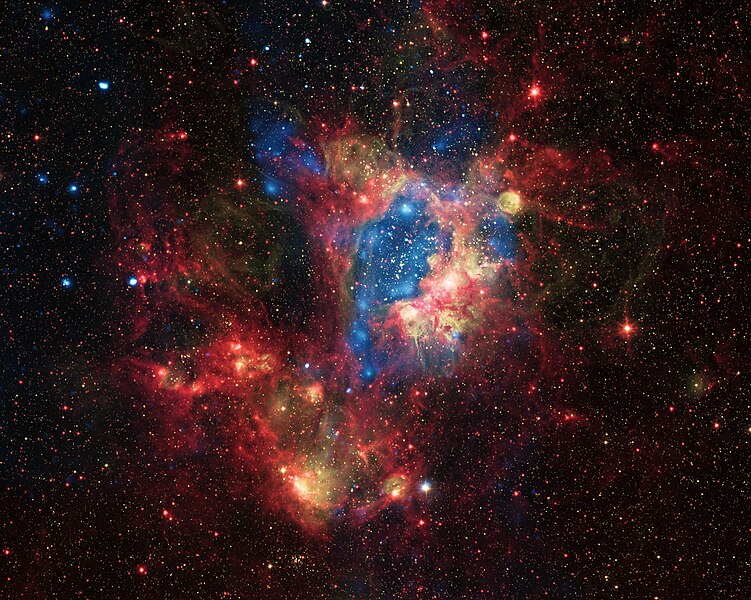File:LHA 120-N 44.jpg

Original file (3,600 × 2,874 pixels, file size: 4.06 MB, MIME type: image/jpeg)
| This is a file from the Wikimedia Commons. Information from its description page there is shown below. Commons is a freely licensed media file repository. You can help. |
Summary
| DescriptionLHA 120-N 44.jpg |
English: This colourful new view shows the star-forming region LHA 120-N44 [1] in the Large Magellanic Cloud, a small satellite galaxy of the Milky Way. This picture combines the view in visible light from the MPG/ESO 2.2-metre telescope at ESO’s La Silla Observatory in Chile with images in infrared light and X-rays from orbiting satellite observatories.
At the centre of this very rich region of gas, dust and young stars lies the star cluster NGC 1929. Its massive stars produce intense radiation, expel matter at high speeds as stellar winds, and race through their short but brilliant lives to explode as supernovae. The winds and supernova shock waves have carved out a huge cavity, called a superbubble, in the surrounding gas. Observations with NASA's Chandra X-ray Observatory (shown here in blue) reveal hot regions created by these winds and shocks, while infrared data from NASA's Spitzer Space Telescope (shown in red) outline where the dust and cooler gas are found. The visible-light view from the MPG/ESO 2.2-metre telescope (in yellow) completes the picture and shows the hot young stars themselves as well as the glowing clouds of gas and dust that surround them. Combining these different views of this dramatic region has allowed astronomers to solve a mystery: why are N44, and similar superbubbles, giving off such strong X-rays? The answer seems to be that there are two extra sources of bright X-ray emission: supernova shock waves striking the walls of the cavities, and hot material evaporating from the cavity walls. This X-ray emission from the edge of the superbubble shows up clearly in the picture. Links Notes [1] The designation of this object indicates that it was included in the Catalogue of H-alpha emission stars and nebulae in the Magellanic Clouds, compiled and published in 1956 by American astronomer–astronaut Karl Henize (1926–1993). The letter “N” indicates that it is a nebula. The object is often called simply N44. |
| Date | |
| Source | http://www.eso.org/public/images/potw1236a/ |
| Author | Optical: ESO, X-ray: NASA/CXC/U.Mich./S.Oey, IR: NASA/JPL |
Licensing
- You are free:
- to share – to copy, distribute and transmit the work
- to remix – to adapt the work
- Under the following conditions:
- attribution – You must give appropriate credit, provide a link to the license, and indicate if changes were made. You may do so in any reasonable manner, but not in any way that suggests the licensor endorses you or your use.
Captions
Items portrayed in this file
depicts
3 September 2012
File history
Click on a date/time to view the file as it appeared at that time.
| Date/Time | Thumbnail | Dimensions | User | Comment | |
|---|---|---|---|---|---|
| current | 11:29, 3 September 2012 |  | 3,600 × 2,874 (4.06 MB) | Jmencisom | User created page with UploadWizard |
File usage
Global file usage
The following other wikis use this file:
Metadata
This file contains additional information, probably added from the digital camera or scanner used to create or digitize it.
If the file has been modified from its original state, some details may not fully reflect the modified file.
| Author | Chandra X-ray Observatory Center |
|---|---|
| Online copyright statement | |
| Source | European Southern Observatory |
| Credit/Provider | Optical: ESO, X-ray: NASA/CXC/U.Mich./S.Oey, IR: NASA/JPL |
| Usage terms |
|
| Image title |
|
| Short title |
|
| Date and time of data generation | 10:00, 3 September 2012 |
| Keywords | LHA 120-N 44 |
| Contact information | cxcpub@cfa.harvard.edu
Karl-Schwarzschild-Strasse 2 Garching bei München, , D-85748 Germany |
